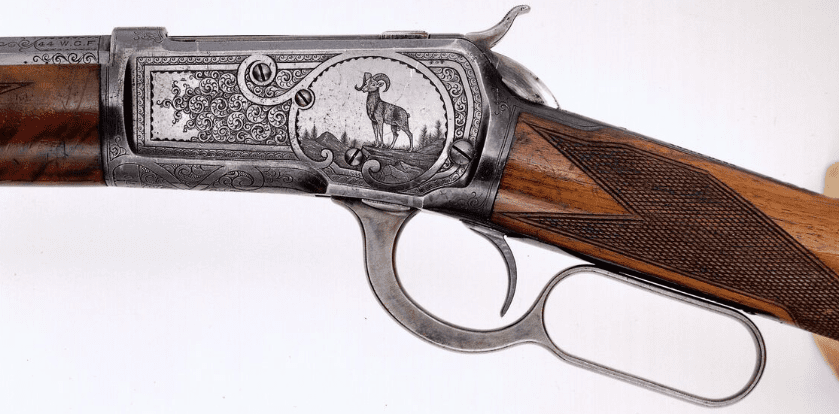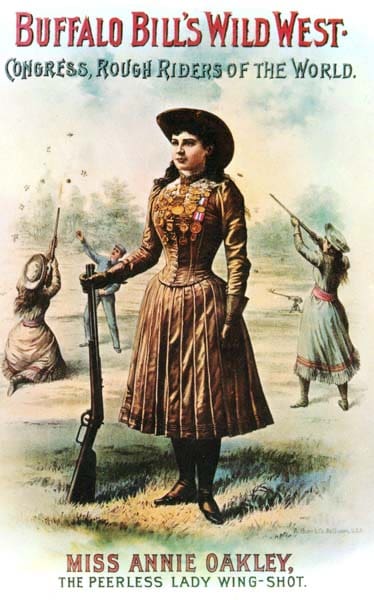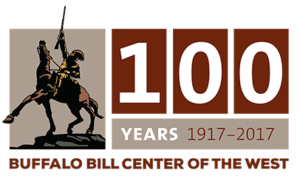It’s safe to say that a lot of people recognize the name Annie Oakley. She’s one of the most iconic shooters in American history, a woman who got her start shooting at a young age.
Oakley (1860 -1926) was born Phoebe Ann Moses and had seven siblings. She learned to hunt at age eight and would sell the game to local businesses in her hometown in Ohio. She had a rather rough life after her father passed away, but when she was a teenager everything changed.
In 1875, famous marksman Frank Butler came to Ohio and challenged locals to a shooting competition. The young Oakley not only showed up, she won. Butler was intrigued by Oakley and courted her; they married a year later. Together, the couple joined Buffalo Bill’s Wild West in 1885. During her time with the Wild West, Oakley amazed audiences all over the world.
This Winchester Model 1892 Lever Action Rifle was one of the guns she used during her arena performances. The rifle, however, has a smoothbore; the performers in Buffalo Bill’s Wild West used bird shot because of their close proximity to the crowds. In fact, a potentially apocryphal story arose that the performers once broke a greenhouse outside of the arena with a bullet and then thought it best to switch to shot.
To look at this rifle, it’s fair to say that it is about as elegant in its engraving as Annie Oakley was in real life, but still packed quite the punch.









Great historical and beautiful piece. I wonder what happened to the rear sight?
“I wonder what happened to the rear sight?”
Being a smoothbore with no rifling, perhaps it was treated like a shotgun, with no rear sight and a bead front, maybe?
Correct. We have one of Buffalo Bill’s Winchester Model 1873’s that was factory made smoothbore and he actually messed with the front site on it to so he could shoot it more like a shotgun
Uh-oh…
Ralph puts Annie Oakley on a pedestal. (So he can look up her skirt.)
Annie Oakley does to Ralph like Shannon does to Dirk… 🙂
“Your comment is awaiting moderation.”
Hey, what gives? There was not one swear or obscene word in there!
Little Sure Shot play on words Geoff?
It looks like it passed moderation, FWW.
I’d just like to know what triggered the ‘awaiting moderation’, that’s all.
My comment was typical male chauvinistic piggery, yeah, but it wasn’t obscene…
I’m betting it was the “… up her skirt” bit. We’ll see, if mine gets moderated as well, we’ll know.
*edit* Nope, seems to have been something else.
He took my name in vain.
Hilariously, it seems like “Annie Oakley” might be the moderation trigger. I just posted a comment that went through fine, but when I edited it and added a line with her name in it, it got moved to moderation…
Edit: That seems to be the case. This one also went to moderation.
All of my posts go to moderation waiting. Not sure if it’s the link to my g+ page or just my name…
It’s your name. We have no control over the WP spam filter. Sorry.
How can a “rifle” be a smoothbore? Lever action shotgun?
If it doesn’t have rifling, it’s not a rifle.
Exactly. I don’t think “Rifle” means what the author thinks it means…
I was wondering exactly the same thing…
It’s sort of a weird circumstance, here, in that the Winchester 1892 is and was a rifle and was never sold commercially in a shotgun variant (as far as I know, at least). I don’t know the background of Annie Oakley’s gun here, but she either ordered a one-off from Winchester and asked them to make an 1892 rifle for her sans rifling or to grind the rifling smooth on one, or she did it as a modification and had the bore ground smooth on a rifle they already owned. I think it’s sort of subjective at this point to say whether modifying a rifle’s barrel so it no longer has rifling makes the firearm a “shotgun” or if it does actually make more sense to then call it a “smoothbore rifle.” Personally, the 1892 is a rifle is this is a very weird example that either didn’t get rifling or had it ground out, and I’m fine with it being called a rifle or a smoothbore rifle. Either way, it’s an awfully pedantic argument haha
There are also such things as rifled shotguns (for shooting slugs), let your noodle bake that one for a bit!
There is a word for this kind of firearm: musket.
Interesting piece and clearly historical, but a rifle, no. That has to be one of the few lever action muskets ever produced.
Aren’t muskets muzzle-loaders?
A musket uses the same thick barrel as rifles do, but is not rifled, unlike the much thinner shotgun barrels. And one would usually assume that muskets are muzzleloaders, since of course all of them were until the end of the Civil War. The utility of the thicker barrel is that it allows someone to shoot ball ammo as well as buck.
There are some “muskets” that are breech loading rifles, the term referring to the fact that it was a “military style” rifle with a full length stock, barrel bands, and usually a bayonet lug. There actually was a Winchester 1873 musket, which I believe was a 30″ barrel. The full length WInchester 1895’s were called muskets as well.
Hi Rusty,
It’s not one of the muskets they made. However those are bad ass and I can do a piece on one. While the title is a massive oxymoron I recognize that, that’s the designation used in the factory records that we house. Perhaps I could have specified that but sometimes you get so used to saying something it doesn’t seem weird anymore
While you’re at it, what’s the caliber? My guess would be .32-20. Since the dovetail was cut, I assume it wasn’t a shotgun tube.
I think it’s .44. I’m out of the office for a week and a half but I’ll confirm when I’m back.
Probably was the .44-40. A commercial shot load for these smoothbore repeaters and other guns were available in that caliber. They were advertised as pest control rounds for semi rural farm areas. I could be wrong but I believe these rounds were further developed into the first .410 shot shells.
Feel free to call it what you like and using the factory terminology works for me. Obviously custom ordered and shot like a shotgun since the rear sight was removed. I concur with J.W.M. on .44-40 guess cool piece of history!
I’d love to see an article on muskets – thanks for offering!
“Lever-action musket” is as much an oxymoron as “smoothbore rifle”. Muskets are muzzle-loaders by definition. The best definition for this gun probably would be a “lever-action shotgun in a rifle caliber”.
Either way, it’s a beautiful firearm, even without the attached history. That it was Annie Oakley’s is just icing on the cake.
In the day Winchester actually had lever action repeating rifles with rifled barrels and full length stocks that came to the muzzle. Winchester advertised them as “Muskets”.
Jay, Curtis, and Rusty… I was thinking the same thing and cringed every time the term “rifle” was used.
There was a good display about her at the NRA convention this year. Annie Oakley was a tough woman, a far cry from the safe space-needing wimps of today.
Interestingly, and with a great deal of prescience, Oakley thought that giving women the vote was a dubious proposition and she didn’t support the female suffrage movement in the WWI era. She thought that there were not enough women who would use their voting rights properly.
History has proven her correct.
She was, however, a vociferous supporter of women arming themselves, and she taught many, many women in her lifetime how to handle guns. Thousands upon thousands of women learned how to handle arms from Annie Oakley. She was a ferociously modest woman, tailoring her own clothes for both function and modesty at the same time.
Annie Oakley is a highly inconvenient bit of history for modern feminists.
Cool gun reminds me of the shot shell converted trapdoor Springfield rifles of the day.
What do you use to clean a smoothbore rifle? Dehydrated water?
Great historical account Ashley, thanks. I really enjoy those. And yes, Winchester did catalog them as smoothbore rifles and carbines….much like the later .22rimfire smoothbore guns by Remington and others.Then there was an episode in the ’60’s when a major rifle builder sent out a batch of .22’s that were inadvertently built without being rifled, ooops….
This sort of thing could happen back in the days before cold hammer forged barrels, because a barrel was drilled, reamed to finish size and then button-rifled or cut-rifled.
So if someone grabbed up a bunch of barrels that had been finished-reamed, but not rifled… whoops.
They used smooth bores with shot because they couldn’t hit the side of a barn with a bullet?
Safety issues. They performed in crowded venues. Even in an arena in NYC. #9 shot was a lot less chancy than a 200 grain .44 caliber slug.
Look at the quality of work on that rifle. That, and more, used to be available in the Winchester catalog – ie, you could order a rifle similar to this by mail from Winchester and have it delivered to you. You could order extra-long/short barrels, barrels in octagon, octagon/round, round configurations, special sight configurations, triggers, inlays, you name it.
Now look at the quality and options available from mass production rifle makers today.
Tell me again how offerings have improved for the gun buyer today. Go ahead, tell me.
What percentage of a man’s monthly income went into purchasing one of those rifles of yesterday as compared to what percentage goes into buying one of those mass produced plastic rifles of today?
What would be more effective at disarming working class Americans? kapo bloomberg or only having rifles of the quality and craftsmanship that you prefer available.
The reality is that those mass produced, cheap rifles and compressed cheeze wizz handguns make firearms ownership a reality for millions more people that would otherwise not have a gun option.
First, your question needs to be modified: What percentage of the buyer’s disposable monthly income were these types of firearms?
Lots of people’s monthly income today is taken up with various schemes of the financial elites: auto insurance, health insurance, home insurance, income taxation, payroll taxation, sale taxes, etc.
None of these issues were taking money out of your paycheck before WWI. Also, before WWI, your money was tied to gold – therefore, it tended to be a competent store of value. The rapacious Federal Reserve wasn’t created until 1913, and the Fed’s cabal of rent-seeking bankers didn’t start inflation and thimblerigging as a deliberate policy until after WWII.
If we assume that the supply of quality guns follows normal economic models of supply and demand, then it stands to reason that people had more money to spend on guns 100+ years ago, because the options in the Winchester catalogs existed and were used by many people and Winchester was making a tidy profit by selling nice guns – and today, Winchester doesn’t even exist as a real company today, only a rollmark and brand name owned by the Belgian defense contractor, FN.
What caliber is it? .25-20, .32-20, 38-40, .44-40? .44-40 would probably have been the best choice for a crimped birdshot load. I wish Winchester would bring back the 9410, and give it the ability to shoot hot-loaded .45LCs like the modern 1892s do. That seems like a cool concept, and as weird as it was the 9410 was better executed than the wonky 1887 if you ask me.
Picking nits about firearms with Ashley Hlebinsky is certainly one of the goofiest thing I’ve seen here on TTAG.
As a Curator at the Cody Firearms Museum, I’d wager Ashley can easily hold her own against run-of-the-mill armchair gunsters habituating this august forum.